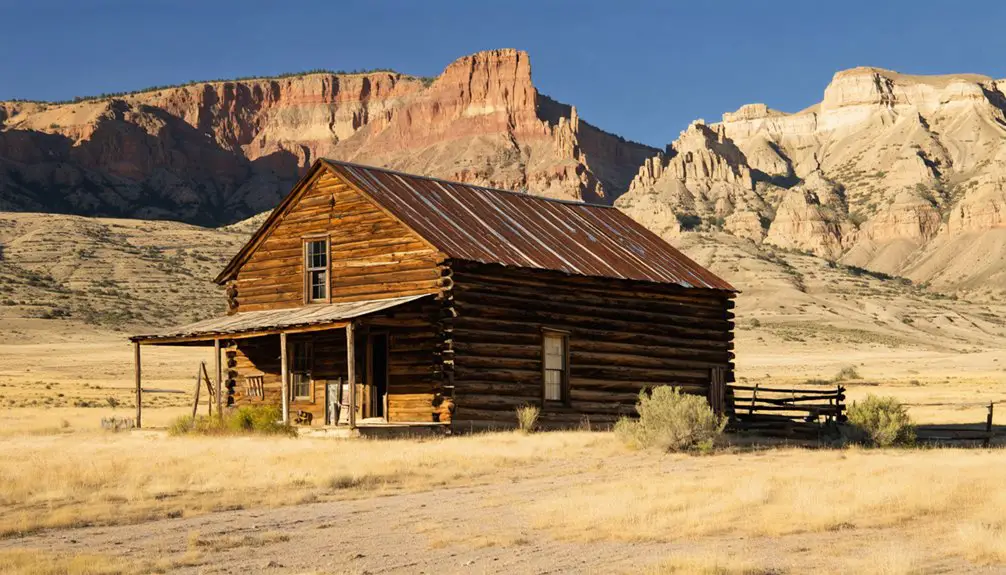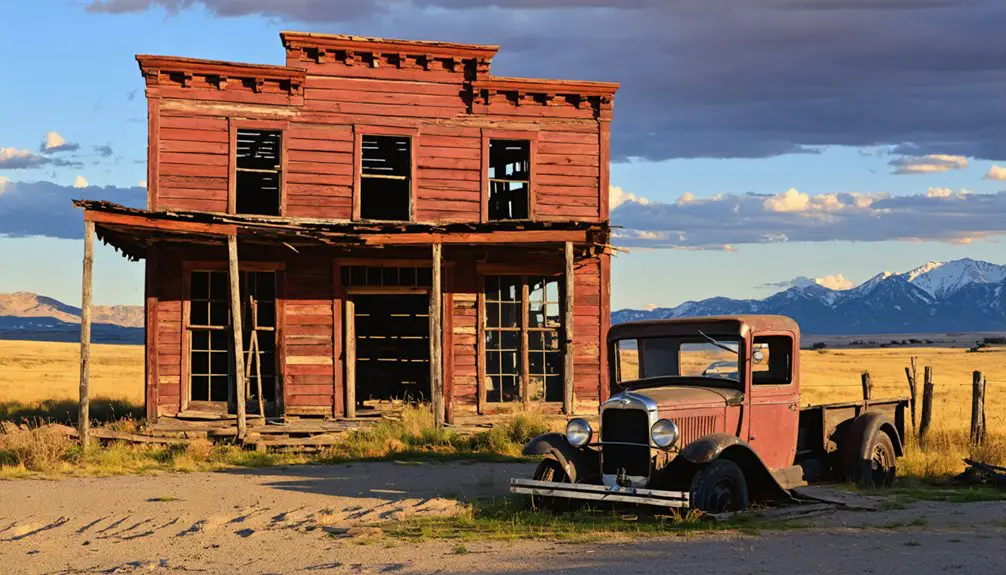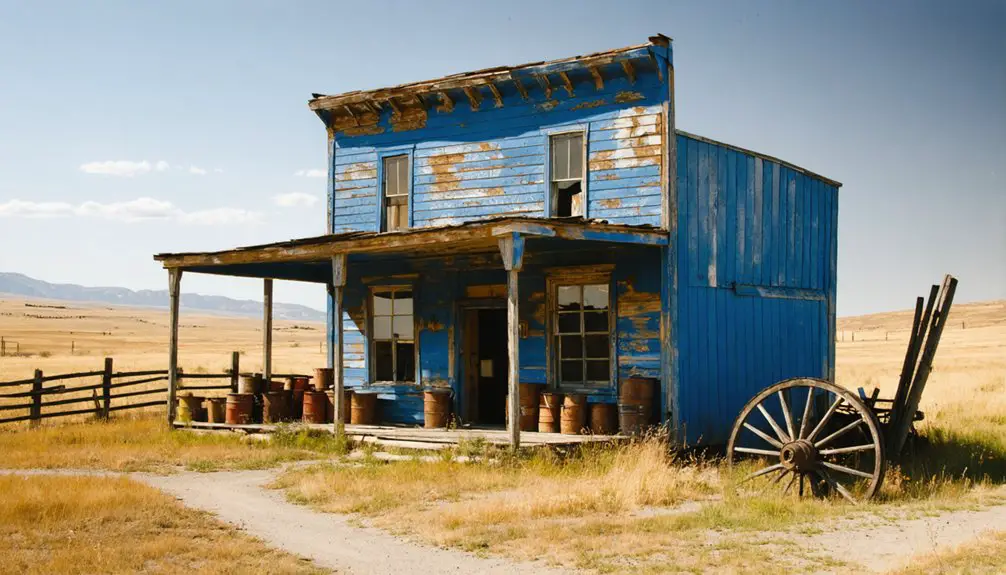You’ll find Hillsboro tucked away in Montana’s Bighorn Canyon, where it began as a small placer mining settlement in the early 1900s. When gold proved scarce, entrepreneur Grosvener W. Barry transformed the area into Cedarvale Ranch, a successful dude ranch catering to railroad tourists seeking authentic Western experiences. Today, eight historic buildings stand preserved within the Bighorn Canyon National Recreation Area, where Barry’s pioneering vision of wilderness tourism still echoes through the canyon walls.
Key Takeaways
- Hillsboro began as a small placer mining settlement in early 1900s but failed to yield significant gold compared to other Montana sites.
- After mining declined, Grosvener W. Barry transformed Hillsboro into Cedarvale Ranch, a successful dude ranch for tourists.
- Eight historic buildings remain and are listed on the National Register of Historic Places, preserved within Bighorn Canyon National Recreation Area.
- The historic post office operated from 1915 to 1945, serving as a community hub for local ranchers and residents.
- The National Park Service maintains Hillsboro’s structures and provides educational programs about its frontier mining and ranching history.
From Gold Rush Dreams to Dude Ranch Reality
While Montana’s major gold rushes of the 1850s and 1860s transformed places like Bannack and Alder Gulch into bustling boomtowns, Hillsboro’s story began later as a smaller placer mining settlement in the early 1900s.
Most miners relied on placer mining techniques to extract loose gold from rock and gravel deposits, though with limited success in the Hillsboro area.
You’ll find that unlike the rich strikes at Last Chance Gulch, Hillsboro’s gold deposits proved disappointingly limited, with mining companies like Grosvener W. Barry’s ventures failing to strike it rich.
Similar to many unsuccessful miners during other gold rushes who turned to alternative occupations, Barry transformed adversity into opportunity.
But that’s when Barry turned adversity into opportunity. Rather than abandon Hillsboro to ghost town status, he pioneered a shift toward dude ranching that would define the area’s future.
His Cedarvale Ranch marketed pristine wilderness and outdoor adventure to railroad tourists, setting a pattern that many Western mining communities would follow.
Enterprising ranch owners turned Montana’s fading mining towns into tourist destinations, offering wilderness escapes to weary city dwellers.
This transformation from mining history to recreational paradise helped Hillsboro survive when its gold mining dreams faded.
The Legacy of Grosvener W. Barry
Though Grosvener W. Barry‘s gold mining ventures didn’t pan out as hoped, his entrepreneurship left an indelible mark on Montana’s Bighorn Canyon.
You’ll find his influence most prominently at Barry’s Landing, named after this ambitious New Yorker who arrived in 1903. While his mining companies failed to strike it rich, Barry’s pivot to ranch management proved more enduring.
He transformed his homestead into Cedarvale Ranch, marketing it as a sportsman’s paradise through railroad vacation guides. The ranch boasted at least ten buildings for visitors to explore. His vision aligned with other ranches like Hillsboro Ranch, which introduced urban visitors to authentic western experiences. After his death from a brain tumor in 1920, his wife Edith and stepson Claude St. John continued his vision, operating the ranch into the 1950s.
Today, you can explore the historic buildings with their distinctive sod roofs, preserved within the Bighorn Canyon National Recreation Area since 1975.
Historic Buildings and Preservation Efforts
Today, eight historic buildings stand as silent witnesses to Hillsboro’s past, each one listed on the National Register of Historic Places.
Similar to how state preservation efforts maintain building integrity in Bannack, you’ll find remarkably preserved structures, including the post office and cabins from the Cedarvale Dude Ranch era, showcasing the architectural significance of early 1900s Montana.
Like the Montana Historical Society, these preservation groups work diligently to safeguard the state’s mining heritage.
- The Bighorn Canyon National Recreation Area oversees historic preservation efforts since 1968
- Cultural Resource Management teams lead stabilization projects using period-appropriate materials
- Youth Conservation Corps members participate in hands-on restoration work
- Grant funding supports ongoing renovation costs and maintenance
When you visit, you’ll experience authentic early ranch life through these carefully maintained buildings.
The site’s preservation efforts have created an immersive window into Montana’s ranching heritage, balancing visitor access with protecting these irreplaceable historic treasures.
Life at Cedarvale Ranch
If you’d visited Cedarvale Ranch in its heyday, you’d have started your day with a hearty ranch breakfast before heading out on guided fishing trips along Trail Creek or hunting expeditions in the Bighorn Canyon wilderness.
You’d have bunked down in one of the ranch’s rustic yet comfortable cabins, sharing meals and stories with fellow guests in the main lodge while being tended to by Barry’s family and ranch staff.
Between boating adventures on the ranch’s powered vessels and authentic cattle ranching activities, you’d have experienced the perfect blend of Western adventure and guided recreation that made Cedarvale one of Montana’s pioneering dude ranches. After Dr. C.W. Barry failed at gold dredging in 1907, he successfully transformed the property into a thriving dude ranch operation.
Daily Ranch Activities
Life at Cedarvale Ranch revolved around a bustling schedule of cattle operations, building maintenance, and agricultural activities that kept ranch hands busy from sunup to sundown.
You’d find yourself managing cattle through changing seasons, tending to essential structures, and maintaining food production for the ranch’s self-sufficiency. The ranch also offered guests unique year-round adventures that complemented the traditional ranching activities. Many visitors learned valuable pressure canning techniques to preserve the ranch’s harvest for winter months.
- Start your day at the blacksmith shop, repairing tools and equipment for ranch operations.
- Move through cattle management tasks – herding, feeding, and breeding operations.
- Check on the milk house and chicken coops for daily dairy and egg collection.
- Make seasonal adjustments to protect livestock and maintain buildings, especially during harsh winters.
The ranch’s routine centered on practical tasks that sustained both animals and people, from preserving food in the root cellar to maintaining the log buildings with their distinctive sod roofs.
Guest Accommodations and Meals
A stay at Cedarvale Ranch offered visitors a unique blend of frontier authenticity and early tourist comfort starting around 1903.
You’d find yourself sleeping in rustic cabins like the “Dude Cabin,” which served as a bunkhouse designed to immerse you in the Western experience. Today’s luxury ranches like Paws Up continue this tradition with their 37,000 pristine acres.
After a day of ranch activities, you’d gather with fellow guests for hearty meals prepared from ranch-raised meats and local produce, enjoying the warmth of wood stoves and fireplaces in communal dining areas.
The ranch’s partnership with the Chicago, Burlington and Quincy Railroad made your journey easier, and once there, you’d discover thoughtful touches like picnic tables and benches scattered around the property for relaxation.
They’d even transport you by motorboat along the Bighorn River from the railhead.
Western Adventure Experiences
While exploring Cedarvale Ranch in the early 1900s, you’d experience western adventure through a unique blend of traditional ranching and innovative tourism.
Grosvener Barry’s pioneering spirit transformed this working ranch into an exciting destination for visitors seeking authentic Montana experiences. You’d arrive in style via motorized boat from Kane, Wyoming, cruising up the Bighorn River to start your western excursions.
- Saddle up for horseback rides through the stunning Big Horn Canyon landscape
- Join daily ranch activities in and around the historic barn and corrals
- Navigate the South Fork Trail Creek area during ranch exploration ventures
- Experience the rustic charm of sod-roofed cabins and traditional blacksmith operations
The ranch’s remote mountain setting provided the perfect backdrop for your immersion into genuine western ranch life.
The Post Office Era and Community Hub
Serving as the heartbeat of rural Montana communication, Hillsboro’s post office opened its doors in 1915 within the small district of Cedarvale.
You’ll find this 1.5-story log building just north of the approach road, where it stood as a symbol of community dynamics for 30 years. The post office’s postal significance extended beyond mere mail delivery – it’s where locals gathered, shared news, and maintained connections with the outside world.
Until its closure in 1945, you’d have found the post office working closely with local ranchers and supporting the area’s evolving economy, from gold dredging to cattle operations.
While the building now stands preserved within the Bighorn Canyon National Recreation Area, it represents an era when rural post offices weren’t just services – they were the glue that held frontier communities together.
Natural Wonders of Bighorn Canyon

As you venture beyond Hillsboro’s ghost town buildings, you’ll encounter Bighorn Canyon’s stunning red cliffs where bighorn sheep navigate the steep terrain amid diverse plant life adapted to both semi-arid and high desert conditions.
You can spot hundreds of bird species soaring past the towering canyon walls, while the spring-fed oases create pockets of lush vegetation that contrast sharply with the surrounding prairie landscape.
The dramatic mountain vistas stretch across 120,000 acres of varied terrain, from forest-covered peaks to broad valleys, offering countless viewpoints to observe the area’s rich wildlife including the famous Pryor Mountain wild horses.
Canyon Flora and Fauna
Located within the dramatic landscape of Bighorn Canyon, an extraordinary collection of plant life thrives across diverse ecological zones.
You’ll discover remarkable plant diversity with 750 species, including 8 endemic species found nowhere else on earth, like the Bighorn Fleabane and Pryor Bladderpod.
- Watch as vegetation changes from dry-loving bluebunch wheatgrass and sagebrush in lower elevations to towering lodgepole pine and Englemann spruce up high.
- Explore stream bottoms where cottonwoods and green ash create shaded sanctuaries.
- Marvel at drought-resistant Utah junipers clinging to rocky canyon walls.
- Spot native flowers from the Asteraceae family, which boasts 167 different species throughout the canyon.
The canyon’s unique terrain creates specialized habitats where plants have adapted to extreme conditions, from sun-scorched cliffs to cool, north-facing slopes.
Scenic Mountain Vistas
Beyond the canyon’s rich plant life stretches a dramatic landscape of towering sandstone cliffs and expansive mountain vistas.
You’ll discover nearly 1,000-foot walls showcasing 38 million years of geological history in stunning layers of tan, orange, and gray sandstone that shift with the changing light.
For the best mountain photography, head to Devil’s Canyon overlook where a natural arch frames your shots perfectly.
You’ll find scenic hikes along 13-15 trails totaling up to 27 miles, offering secluded viewpoints of the dramatic scenery.
Don’t miss the sunrise and sunset views when the canyon walls come alive with color.
At night, you can capture incredible shots of the Milky Way against the canyon’s silhouette, thanks to minimal light pollution in the area.
National Park Service Stewardship
While many ghost towns across Montana have fallen into disrepair, the National Park Service plays an essential role in preserving these historic treasures through extensive stewardship programs.
You’ll find dedicated teams of archaeologists, interpreters, and maintenance staff working to protect cultural heritage while guaranteeing you can safely explore these remnants of the past.
- NPS manages ghost town preservation through detailed environmental and management plans
- Staff maintains historic structures, roads, and foundations while protecting artifacts from vandalism
- Educational programs and walking tours bring frontier mining stories to life
- Special partnerships with tribal entities and local communities guarantee proper cultural context
The NPS’s careful balance of public access and resource protection means you’re free to experience these fascinating historical sites while they’re preserved for future generations.
Ghost Town Tourism Today

The preservation efforts of the National Park Service have laid strong groundwork for today’s thriving ghost town tourism industry.
You’ll find a vibrant mix of history buffs, photographers, and adventure seekers exploring Hillsboro’s weathered structures and forgotten streets. While visitor engagement has evolved through social media and virtual tours, the real draw remains the authentic experience of stepping back in time.
Local guides offer immersive storytelling tours, and seasonal events bring the town’s past to life.
Ghost town preservation remains a delicate balance – you’ll notice carefully maintained walkways and interpretive signs while the buildings retain their haunting authenticity.
If you’re planning a visit, you’ll benefit from improved infrastructure that makes the site more accessible while still preserving its remote, mysterious character.
Frequently Asked Questions
What Was the Average Temperature in Hillsboro During Its Peak Years?
You’d find historical weather patterns showed winter temps averaging 0-30°F and summer temps hitting 60-80°F, though climate change wasn’t tracked then like today’s detailed mountain climate data.
Were There Any Documented Conflicts Between Native Americans and Early Settlers?
You’d think a mining town would spark fierce battles, but surprisingly, there aren’t any specific documented conflicts between Native Americans and settlers in Hillsboro, though tensions existed throughout Montana’s broader region.
How Much Did It Cost to Stay at Cedarvale Ranch?
You’d likely have paid $5-15 per day for Cedarvale Ranch accommodations in early 1900s, including modern amenities like electrical lighting, motorboat transport, guided activities, and fresh meals from their garden.
What Happened to the Mining Equipment After the Gold Rush Ended?
You’ll find most mining equipment was abandoned onsite when it wasn’t worth moving, though valuable pieces were salvaged. Today, you can still see this abandoned machinery preserved as historical artifacts.
Did Any Famous Historical Figures Ever Visit Hillsboro or Cedarvale Ranch?
Like footprints in untouched snow, you won’t find traces of famous visitors at either location. Historical records don’t show any celebrated figures stopping by Cedarvale Ranch or Hillsboro during their operating years.
References
- https://www.nps.gov/bica/learn/historyculture/hillsboro-historic-structures.htm
- https://www.newmexico.org/places-to-visit/ghost-towns/hillsboro/
- https://www.garnetghosttown.org/history.php
- https://www.mountain-home.com/blog/vacation-planning/guide-montana’s-ghost-towns
- https://www.nps.gov/bica/learn/historyculture/hillsboro.htm
- https://mhs.mt.gov/education/textbook/chapter6/Chapter6.pdf
- https://southwestmt.com/specialfeatures/history/lureofgold/
- https://en.wikipedia.org/wiki/Gold_rush
- https://montanakids.com/history_and_prehistory/Frontier_Life/early.htm
- https://en.wikipedia.org/wiki/Cedarvale_(Hillsboro



